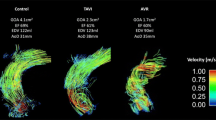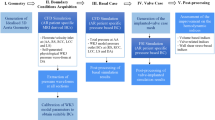Abstract
This paper presents the analysis of detailed hemodynamics in the aortas of four patients following replacement with a composite bio-prosthetic valve-conduit. Magnetic resonance image-based computational models were set up for each patient with boundary conditions comprising subject-specific three-dimensional inflow velocity profiles at the aortic root and central pressure waveform at the model outlet. Two normal subjects were also included for comparison. The purpose of the study was to investigate the effects of the valve-conduit on flow in the proximal and distal aorta. The results suggested that following the composite valve-conduit implantation, the vortical flow structure and hemodynamic parameters in the aorta were altered, with slightly reduced helical flow index, elevated wall shear stress and higher non-uniformity in wall shear compared to normal aortas. Inter-individual analysis revealed different hemodynamic conditions among the patients depending on the conduit configuration in the ascending aorta, which is a key factor in determining post-operative aortic flow. Introducing a natural curvature in the conduit to create a smooth transition between the conduit and native aorta may help prevent the occurrence of retrograde and recirculating flow in the aortic arch, which is particularly important when a large portion or the entire ascending aorta needs to be replaced.







Similar content being viewed by others
References
Barker, A. J., C. Lanning, and R. Shandas. Quantification of hemodynamic wall shear stress in patients with bicuspid aortic valve using phase-contrast MRI. Ann. Biomed. Eng. 38:788–800, 2010.
Bentall, H., and A. Debono. A technique for complete replacement of the ascending aorta. Thorax 23:338–339, 1968.
Bochenek-Klimczyk, K., K. K. Lau, M. Galinanes, and A. W. Sosnowski. Preassembled stentless valved-conduit for the replacement of the ascending aorta and aortic root. Interact. CardioVasc. Thorac. Surg. 7:964–968, 2008.
Borger, M. A., S. M. Carson, J. Ivanov, V. Rao, H. E. Scully, C. M. Feindel, et al. Stentless aortic valves are hemodynamically superior to stented valves during mid-term follow-up: a large retrospective study. Ann. Thorac. Surg. 80:2180–2185, 2005.
Brown, A. G., Y. Shi, A. Marzo, C. Staicu, I. Valverde, P. Beerbaum, P. V. Lawford, and D. R. Hose. Accuracy vs. computational time: translating aortic simulations to the clinic. J. Biomech. 45:516–523, 2012.
Chatzizisis, Y. S., A. U. Coskun, M. Jonas, E. R. Edelman, P. H. Stone, and C. L. Feldman. Risk stratification of individual coronary lesions using local endothelial shear stress: a new paradigm for managing coronary artery disease. Curr. Opin. Cardiol. 22:552–564, 2007.
Cheng, Z. Analysis of blood flow in patient-specific models of type B aortic dissection. PhD Thesis. Imperial College London, 2012.
Cibis, M., W. V. Potters, F. J. Gijsen, H. Marquering, E. vanBavel, A. F. van der Steen, A. J. Nederveen, and J. J. Wentzel. Wall shear stress calculations based on 3D cine phase contrast MRI and computational fluid dynamics: a comparison study in healthy carotid arteries. NMR Biomed. 27:826–834, 2014.
Davies, J. E., K. H. Parker, D. P. Francis, A. D. Hughes, and J. Mayet. What is the role of the aorta in directing coronary blood flow? Heart 94:1545–1547, 2008.
Di Bartolomeo, R., L. Botta, A. Leone, E. Pilato, S. Martin-Suarez, M. Bacchini, et al. Bio-Valsalva prosthesis: ‘new’ conduit for ‘old’ patients. Interact. CardioVasc. Thorac. Surg. 7:1062–1066, 2008.
Fedak, P. W. M., S. Verma, T. E. David, R. L. Leask, R. D. Weisel, and J. Butany. Clinical and pathophysiological implications of a bicuspid aortic valve. Circulation 106:900–904, 2002.
Grigioni, M., C. Daniele, U. Morbiducci, C. Del Gaudio, G. D’Avenio, A. Balducci, and V. Barbaro. A mathematical description of blood spiral flow in vessels: application to a numerical study of flow in arterial bending. J. Biomech. 38(7):1375–1386, 2005.
Hope, T. A., M. Markl, L. Wigstrom, M. T. Alley, D. C. Miller, and R. J. Herfkens. Comparison of flow patterns in ascending aortic aneurysms and volunteers using four-dimensional magnetic resonance velocity mapping. J. Magn. Reson. Imaging 26(6):1471–1479, 2007.
Kaya, A., R. H. Heijmen, J. C. Kelder, and W. J. Morshuis. First 102 patients with the BioValsalva conduit for aortic root replacement. The Annals of thoracic surgery 94:72–77, 2012.
Kaya, A., R. H. Heijmen, J. C. Kelder, M. A. Schepens, and W. J. Morshuis. Stentless biological valved conduit for aortic root replacement: initial experience with the Shelhigh BioConduit model NR-2000C. J. Thorac. Cardiovasc. Surg. 141:1157–1162, 2011.
Kidher, E., Z. Cheng, O. A. Jarral, D. P. O’Regan, X. Y. Xu, and T. Athanasiou. In vivo assessment of the morphology and hemodynamic functions of the BioValsalva composite valve-conduit graft using cardiac magnetic resonance imaging and computational modelling technology. J. Cardiothorac. Surg. 9:193, 2014.
Kilner, P. J., G. Z. Yang, R. H. Mohiaddin, D. N. Firmin, and D. B. Longmore. Helical and retrograde secondary flow patterns in the aortic arch studied by three-directional magnetic resonance velocity mapping. Circulation 88(5):2235–2247, 1993.
Langtry, R. B., and F. R. Menter. Correlation-based transition modeling for unstructured parallelized computational fluid dynamics codes. AIAA J. 47:2894–2906, 2009.
Lau, K. K., K. Bochenek-Klimczyk, M. Galinanes, and A. W. Sosnowski. Replacement of the ascending aorta, aortic root, and valve with a novel stentless valved conduit. Ann. Thorac. Surg. 86:278–281, 2008.
Lehoux, S., Y. Castier, and A. Tedgui. Molecular mechanisms of the vascular responses to hemodynamic forces. J. Intern. Med. 259:381–392, 2006.
Li, Y. S. J., J. H. Haga, and S. S. Chien. Molecular basis of the effects of shear stress on vascular endothelial cells. J. Biomech. 38:1949–1971, 2005.
Lin, A. C., A. Lowe, K. Sidhu, W. Harrison, P. Ruygrok, and R. Stewart. Evaluation of a novel sphygmomanometer, which estimates central aortic blood pressure from analysis of brachial artery suprasystolic pressure waves. J. Hypertens. 30(9):1743–1750, 2012.
Liu, X., Y. Fan, X. Deng, and F. Zhan. Effect of non-Newtonian and pulsatile blood flow on mass transport in the human aorta. J. Biomech. 44:1123–1131, 2011.
Liu, X., A. Sun, Y. Fan, and X. Deng. Physiological significance of helical flow in the arterial system and its potential clinical applications. Ann. Biomed. Eng. 43:3–15, 2015.
Liu, X., P. Weale, G. Reiter, A. Kino, K. Dill, T. Gleason, T. Carroll, and J. Carr. Breathhold time-resolved three-directional MR velocity mapping of aortic flow in patients after aortic valve-sparing surgery. J. Magn. Reson. Imaging 29(3):569–575, 2009.
Malek, A. M., S. L. Alper, and S. Izumo. Hemodynamic shear stress and its role in atherosclerosis. J. Am. Med. Assoc. 282(21):2035–2042, 1999.
Markl, M., M. T. Draney, M. D. Hope, J. M. Levin, F. P. Chan, M. T. Alley, N. J. Pelc, and R. J. Herfkens. Time-resolved 3-dimensional velocity mapping in the thoracic aorta: visualization of 3-directional blood flow patterns in healthy volunteers and patients. J. Comput. Assist. Tomogr. 28(4):459–568, 2004.
Markwald, R. R., R. A. Norris, R. Moreno-Rodriguez, and R. A. Levine. Developmental basis of adult cardiovascular diseases: valvular heart diseases. Ann. N. Y. Acad. Sci. 1188:177–183, 2010.
Melina, G., F. De Robertis, J. A. Gaer, M. Amrani, A. Khaghani, and M. H. Yacoub. Mid-term pattern of survival, hemodynamic performance and rate of complications after Medtronic freestyle versus homograft full aortic root replacement: results from a prospective randomized trial. J. Heart Valve Dis. 13:972–975, 2004; (discussion 75–76).
Morbiducci, U., R. Ponzini, D. Gallo, C. Bignardi, and G. Rizzo. Inflow boundary conditions for image-based computational hemodynamics: impact of idealized versus measured velocity profiles in the human aorta. J. Biomech. 46(1):102–109, 2013.
Morbiducci, U., R. Ponzini, G. Rizzo, M. Cadioli, A. Esposito, F. De Cobelli, A. Del Maschio, F. M. Montevecchi, and A. Redaelli. In vivo quantification of helical blood flow in human aorta by time-resolved three-dimensional cine phase contrast magnetic resonance imaging. Ann. Biomed. Eng. 37(3):516–531, 2009.
Morbiducci, U., R. Ponzini, G. Rizzo, M. Cadioli, A. Esposito, F. M. Montevecchi, and A. Redaelli. Mechanistic insight into the physiological relevance of helical blood flow in the human aorta: an in vivo study. Biomech. Model. Mechanobiol. 10(3):339–355, 2011.
Nishimura, R. A. Aortic valve disease. Circulation 106:770–772, 2002.
Nkomo, V. T., J. M. Gardin, T. N. Skelton, J. S. Gottdiener, C. G. Scott, and M. Enriquez-Sarano. Burden of valvular heart diseases: a population-based study. Lancet 368:1005–1011, 2006.
Taylor, C. A., and D. A. Steinman. Image-based modelling of blood flow and vessel wall dynamics: applications, methods and future directions. Ann. Biomed. Eng. 38(3):1188–1203, 2010.
Torii, R., I. El-Hamamsy, M. Donya, S. V. Babu-Narayan, M. Ibrahim, P. J. Kilner, R. H. Mohiaddin, X. Y. Xu, and M. H. Yacoub. Integrated morphologic and functional assessment of the aortic root after different tissue valve root replacement procedures. J. Thorac. Cardiovasc. Surg. 143(6):1422–1428, 2012.
Zamir, M., P. Sinclair, and T. H. Wonnacott. Relation between diameter and flow in major branches of the arch of the aorta. J. Biomech. 25(11):1303–1310, 1992.
Zilla, P., D. Bezuidenhout, and P. Human. Prosthetic vascular grafts: wrong models, wrong questions and no healing. Biomaterials 28(34):5009–5027, 2007.
Acknowledgments
This work was supported by Vascutek Terumo, Renfrewshire, Scotland and the National Institute for Health Research Biomedical Research Centre based at Imperial College Healthcare NHS Trust and Imperial College London. The authors declare that although Vascutek Terumo partially supported this study, the funding company had no control, input or influence on the study design, data analysis or publications.
Author information
Authors and Affiliations
Corresponding author
Additional information
Associate Editor Umberto Morbiducci oversaw the review of this article.
Rights and permissions
About this article
Cite this article
Cheng, Z., Kidher, E., Jarral, O.A. et al. Assessment of Hemodynamic Conditions in the Aorta Following Root Replacement with Composite Valve-Conduit Graft. Ann Biomed Eng 44, 1392–1404 (2016). https://doi.org/10.1007/s10439-015-1453-x
Received:
Accepted:
Published:
Issue Date:
DOI: https://doi.org/10.1007/s10439-015-1453-x




